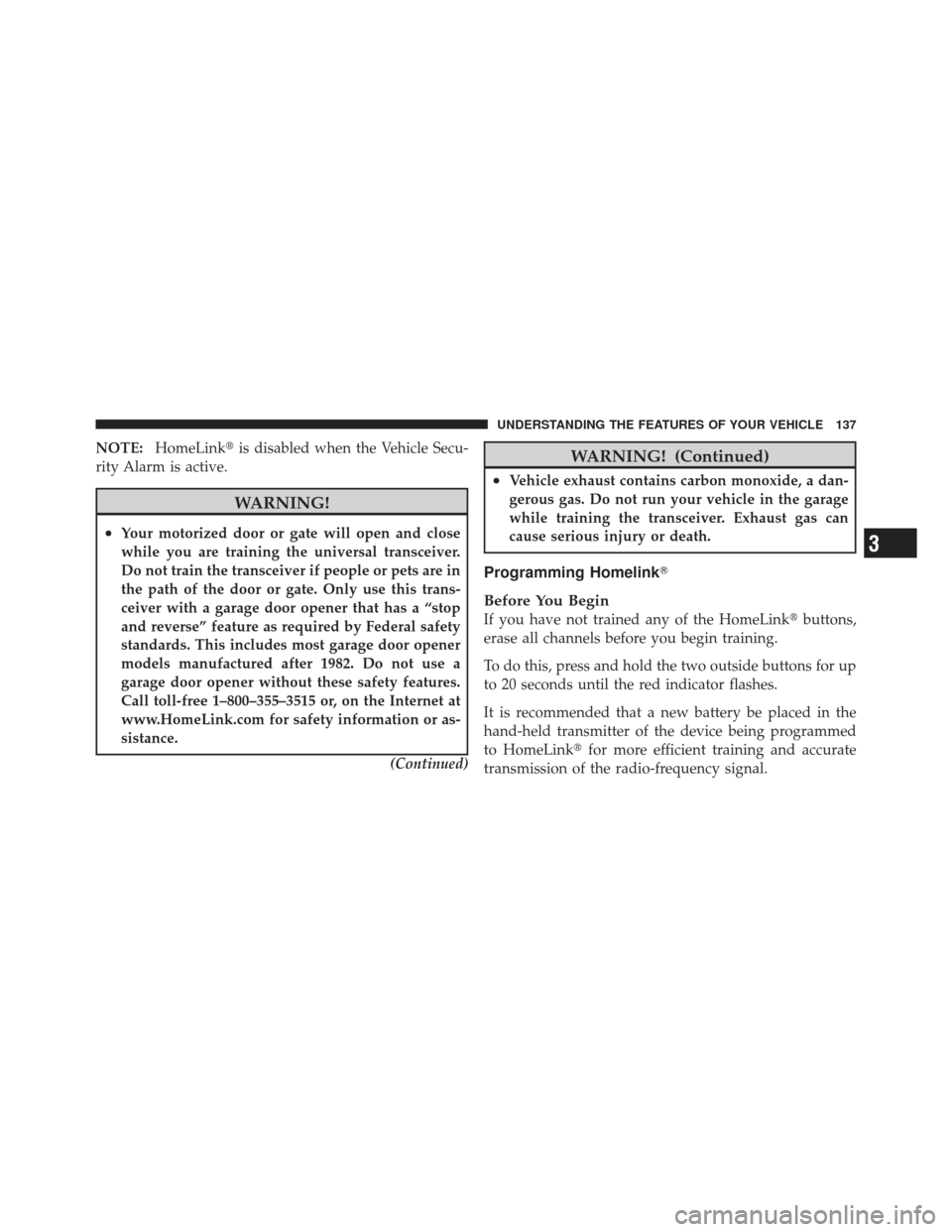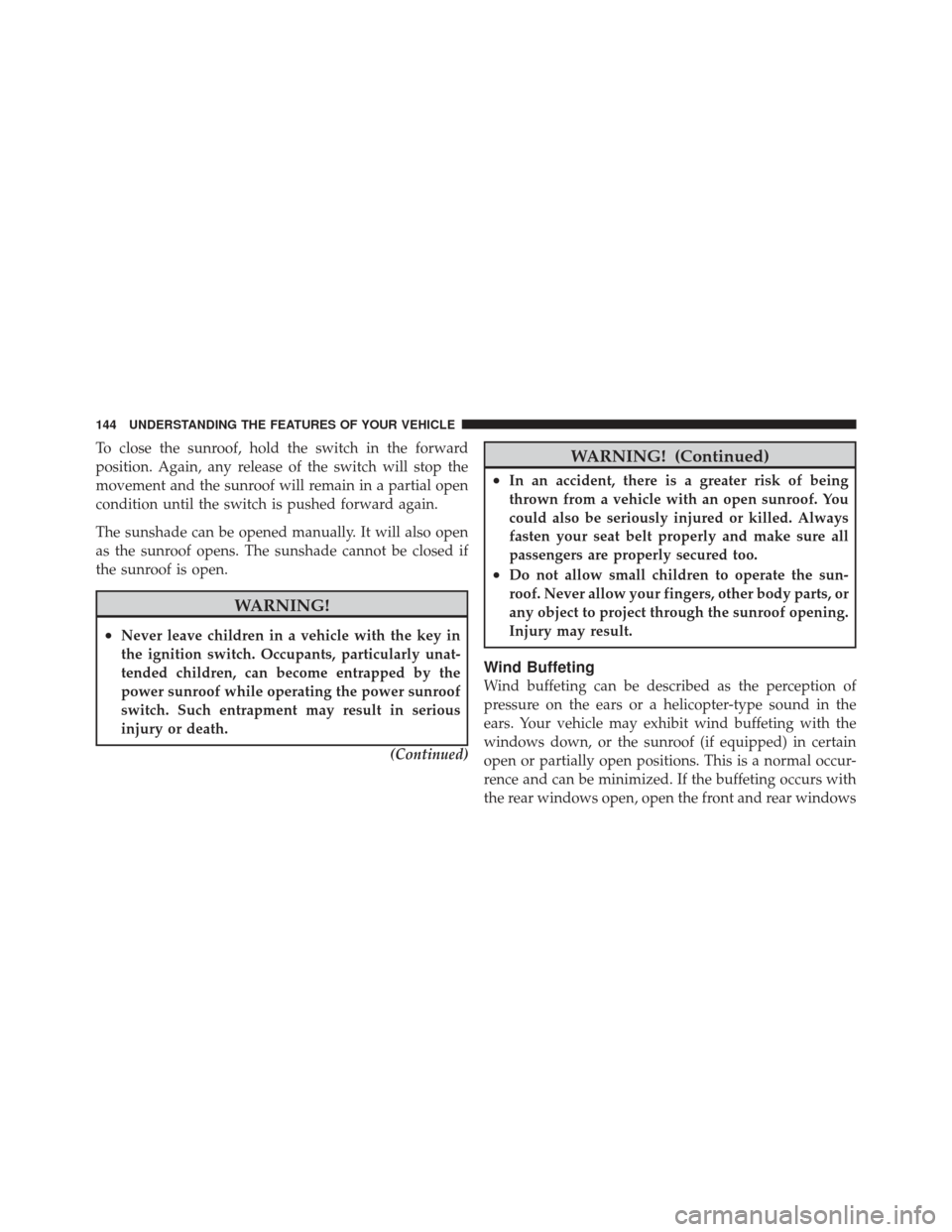Page 139 of 410

NOTE:HomeLink� is disabled when the Vehicle Secu-
rity Alarm is active.
WARNING!
•Your motorized door or gate will open and close
while you are training the universal transceiver.
Do not train the transceiver if people or pets are in
the path of the door or gate. Only use this trans-
ceiver with a garage door opener that has a “stop
and reverse” feature as required by Federal safety
standards. This includes most garage door opener
models manufactured after 1982. Do not use a
garage door opener without these safety features.
Call toll-free 1–800–355–3515 or, on the Internet at
www.HomeLink.com for safety information or as-
sistance.
(Continued)
WARNING! (Continued)
•Vehicle exhaust contains carbon monoxide, a dan-
gerous gas. Do not run your vehicle in the garage
while training the transceiver. Exhaust gas can
cause serious injury or death.
Programming Homelink�
Before You Begin
If you have not trained any of the HomeLink �buttons,
erase all channels before you begin training.
To do this, press and hold the two outside buttons for up
to 20 seconds until the red indicator flashes.
It is recommended that a new battery be placed in the
hand-held transmitter of the device being programmed
to HomeLink� for more efficient training and accurate
transmission of the radio-frequency signal.
3
UNDERSTANDING THE FEATURES OF YOUR VEHICLE 137
Page 146 of 410

To close the sunroof, hold the switch in the forward
position. Again, any release of the switch will stop the
movement and the sunroof will remain in a partial open
condition until the switch is pushed forward again.
The sunshade can be opened manually. It will also open
as the sunroof opens. The sunshade cannot be closed if
the sunroof is open.
WARNING!
•Never leave children in a vehicle with the key in
the ignition switch. Occupants, particularly unat-
tended children, can become entrapped by the
power sunroof while operating the power sunroof
switch. Such entrapment may result in serious
injury or death.(Continued)
WARNING! (Continued)
•In an accident, there is a greater risk of being
thrown from a vehicle with an open sunroof. You
could also be seriously injured or killed. Always
fasten your seat belt properly and make sure all
passengers are properly secured too.
•Do not allow small children to operate the sun-
roof. Never allow your fingers, other body parts, or
any object to project through the sunroof opening.
Injury may result.
Wind Buffeting
Wind buffeting can be described as the perception of
pressure on the ears or a helicopter-type sound in the
ears. Your vehicle may exhibit wind buffeting with the
windows down, or the sunroof (if equipped) in certain
open or partially open positions. This is a normal occur-
rence and can be minimized. If the buffeting occurs with
the rear windows open, open the front and rear windows
144 UNDERSTANDING THE FEATURES OF YOUR VEHICLE
Page 148 of 410
There is one optional power outlet located in the right
rear cargo area.The rear power outlet is powered directly by the battery.
As an option, fuse #11 in the Integrated Power Module
(IPM), may be repositioned to allow power to come from
the ignition switch only, when in the ON or ACC
position.
NOTE:
The rear power outlet will not accept a cigar
lighter unit as it is intended only for accessory items.
WARNING!
To avoid serious injury or death:
•Do not use a three-prong adapter.
•Do not insert any objects into the receptacles.
•Do not touch with wet hands.
•Close the lid when not in use and while driving
the vehicle.
•If this outlet is mishandled, it may cause an
electric shock and failure.
Rear Power Outlet
146 UNDERSTANDING THE FEATURES OF YOUR VEHICLE
Page 151 of 410

CAUTION!
•Many accessories that can be plugged in draw
power from the vehicle’s battery, even when not in
use (i.e., cellular phones, etc.). Eventually, if
plugged in long enough, the vehicle’s battery will
discharge sufficiently to degrade battery life
and/or prevent engine starting.
•Accessories that draw higher power (i.e., coolers,
vacuum cleaners, lights, etc.), will discharge the
battery even more quickly. Only use these inter-
mittently and with greater caution.
•After the use of high-power draw accessories, or
long periods of the vehicle not being started (with
accessories still plugged in), the vehicle must be
driven a sufficient length of time to allow the
generator to recharge the vehicle’s battery.
REAR SHELF PANEL — IF EQUIPPED
The Rear Shelf Panel attaches to guides in the rear cargo
area. The rear shelf panel may be installed in one of five
different positions.
NOTE:The liftgate may be opened or closed with the
rear cargo shelf panel in position 1, position 2, position 3
or position 4.
WARNING!
•To avoid tipping, lock the shelf securely in all
positions.
•Do not drive this vehicle with the liftgate open, or
use the shelf as a seat.
•Failure to follow these warnings could result in
serious or fatal injury.
3
UNDERSTANDING THE FEATURES OF YOUR VEHICLE 149
Page 152 of 410
Position 1 (Top)
Insert the front outboard corners of the shelf panel into
the top guides and slide forward. Press down on the back
of the shelf panel to lock it into place.WARNING!
Do not load objects on the shelf in position 1 (top). In
an accident, objects could strike occupants causing
serious or fatal injury.
Position 2 (Middle)
Insert the front outboard corners of the shelf panel into
the middle guides and slide forward. Press down on the
back of the shelf panel to lock it into place.
Rear Shelf Panel Position 1
150 UNDERSTANDING THE FEATURES OF YOUR VEHICLE
Page 153 of 410
WARNING!
Do not load objects over 100 lbs (45 kg) in position 2
(middle). Failure to follow this warning could cause
the shelf to collapse resulting in personal injury.
Position 3 (Floor)
Insert the front outboard corners of the shelf panel into
the bottom guides and slide forward.
NOTE:To carry items that may soil the carpeting, the
rear shelf panel may be inverted in position 2 or position
3.
Rear Shelf Panel Position 2
3
UNDERSTANDING THE FEATURES OF YOUR VEHICLE 151
Page 154 of 410
Position 4 (Vertical)
Insert the front outboard corners of the shelf panel into
the vertical guides behind the rear seatbacks near the
floor and slide downward. Push the shelf panel forward
to lock it by aligning the vertical guide with the rubber
stop of the shelf panel.WARNING!
When in the vertical position, the rear shelf panel
should not be used as a barrier for large objects in the
cargo area with the seatbacks folded down. In an
accident objects could strike the seatbacks or occu-
pants causing serious or fatal injury.
Position 5 (Table)
With the liftgate open the rear shelf panel can be moved
rearward to act as a serving counter.
1. Align the front corners of the shelf panels with the lock
position on the backside of the top rear guides. Press
down on the shelf panel to lock it into place.
Rear Shelf Panel Position 4
152 UNDERSTANDING THE FEATURES OF YOUR VEHICLE
Page 155 of 410
2. Twist the knob on the underside of the panel and
lower the shelf leg.
3. Install the shelf leg into the liftgate latch area as
labeled on the rear scuff plate.
WARNING!
Do not load objects over 100 lbs (45 kg) in position 5
(table). Failure to follow this warning could cause the
shelf to collapse resulting in personal injury.
Rear Shelf Leg Release Knob
Rear Shelf Panel Position 5
3
UNDERSTANDING THE FEATURES OF YOUR VEHICLE 153